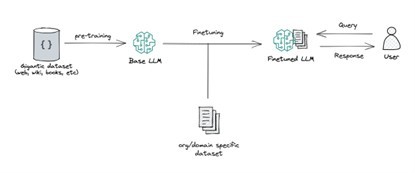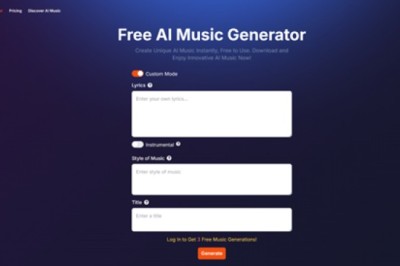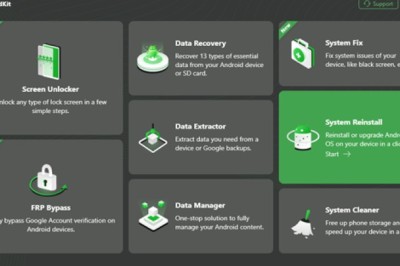views

One of the hottest topics in AI right now is RAG, or retrieval-augmented generation, a retrieval method used by AI tools to improve the quality and relevance of their outputs.
This blog post will guide you about how RAG works, its key differences from traditional AI models, and how it improves AI development. We discuss applications, benefits, and the future potential of RAG in various industries.
Understanding the Functionality of Retrieval-Augmented Generation
Retrieval augmented generation is an exciting concept in the field of generative AI. It involves combining two important components: retrieval models and generation models. Retrieval models help find relevant information or examples from a large dataset, while generation models use that information to create new content.
Unlike traditional generative models that generate content from scratch, retrieval-augmented generation takes advantage of pre-existing knowledge. By incorporating retrieval models, the generation process becomes more context-aware and produces relevant and coherent content. This approach is particularly useful in tasks like natural language generation, image and video generation, and creative content generation.
With retrieval-augmented generation, AI systems can generate more accurate, controlled, and tailored outputs to specific domains or contexts. It opens up exciting possibilities for creating personalized virtual assistants, improving content generation in various domains, and enhancing the overall quality of generative AI systems.
The Components of Retrieval-Augmented Generation
Retrieval-augmented generation relies on two crucial components: retrieval models and generation models. Let's look at each of these components and their integration.
Retrieval Models
These models play a vital role in retrieval-augmented generation by finding relevant information or examples from a vast dataset. There are various types of retrieval models, including:
Semantic Search
This retrieval model understands the meaning and context of the search query and retrieves relevant information based on semantic similarity.
Content-Based Image Retrieval
In this case, the retrieval model analyzes the visual features of images and retrieves similar images based on those features.
Generation Models
These models are responsible for generating new content based on the retrieved information. Some common types of generation models include:
Language Models
Language models are designed to generate coherent and contextually appropriate text. They can be trained on vast amounts of text data to understand language patterns and generate human-like text.
Image Generators
These models generate new images based on the retrieved information. They learn patterns and features from existing images and use that knowledge to create new ones.
Integration of Retrieval and Generation Models
The retrieval and generation models are combined to create a retrieval-augmented generation system. The retrieval model helps select relevant information from the dataset, which is then fed into the generation model. The generation model utilizes this retrieved information to produce more accurate, context-aware content, and aligned with the desired output.
What is Fine-Tuning?
Fine-tuning is a process in machine learning where a pre-trained model is further trained on a new dataset to adapt it to a specific task or improve its performance. Think of it as taking a well-educated person with general knowledge about many subjects and giving them additional training to excel in a particular job or skill.
Pre-trained Model
This model has already been trained on a large dataset, often on a broad range of topics. These models have learned general patterns and knowledge.
Additional Training
In fine-tuning, this pre-trained model undergoes further training on a smaller, task-specific dataset. This helps the model to adjust its parameters and improve its performance for the specific task.
Importance of Fine-Tuning in Machine Learning
Fine-tuning is crucial in machine learning for several reasons:
Adaptation to Specific Tasks
Pre-trained models are often generic and may not perform optimally on specific tasks. Fine-tuning allows these models to adapt to the nuances of a particular problem, improving their accuracy and effectiveness.
Resource Efficiency
Training a model from scratch, especially complex ones like deep neural networks, requires significant computational resources and time. Fine-tuning a pre-trained model is much more efficient, as it leverages the model's existing knowledge.
Performance Improvement
By fine-tuning, models can achieve better performance on specific tasks compared to using them as-is. This is because the additional training helps the model to fine-tune its understanding and predictions based on the new data.
Keeping Up with Changes
Data and requirements can change over time. Fine-tuning allows models to be updated and maintained effectively, ensuring they remain relevant and accurate as new data becomes available.
General Benefits of Fine-Tuning AI Models
Fine-tuning AI models offers several benefits that enhance their effectiveness and usability:
Customization
Fine-tuning allows models to be customized for specific applications. For example, a language model pre-trained on general text can be fine-tuned to perform better in legal document analysis or medical diagnosis by training it on relevant datasets.
Improved Accuracy
Fine-tuning helps reduce errors and improve the precision of model predictions. This is particularly important in critical applications like healthcare, finance, and autonomous driving, where accuracy is paramount.
Cost-Effective
Fine-tuning existing models is more cost-effective than investing resources in training new models from scratch. It reduces the need for extensive computational power and large datasets.
Faster Deployment
Fine-tuning enables quicker deployment of AI solutions. Since the base model is already trained, the additional training required for fine-tuning is relatively short, speeding up the time to market.
Leveraging Pre-existing Knowledge
Fine-tuned models leverage the vast amount of knowledge embedded in pre-trained models. This means they start with a strong foundation and only need to adjust for the specifics, making them robust and reliable.
Continuous Improvement
Fine-tuning can be an ongoing process. As new data comes in, models can be periodically fine-tuned to maintain and enhance their performance, ensuring they stay up-to-date with the latest information and trends.
Why is Fine-Tuning Essential for Artificial Intelligence?
RAG models combine the power of retrieval (fetching relevant documents or information) with generation (creating coherent and contextually accurate text). Fine-tuning these models is essential for several reasons:
Enhancing Accuracy and Relevance
Fine-tuning is crucial for RAG (Retrieval-Augmented Generation) models because it significantly enhances their accuracy and relevance. The model learns to retrieve and generate highly relevant information tailored to specific queries by fine-tuning.
This targeted approach ensures that the information pulled in is accurate and contextually appropriate, leading to better and more useful responses. The process of fine-tuning helps the model understand the context of the queries more deeply, reducing errors and improving the overall quality of the generated responses.
Customizing to Specific Domains or Tasks
Customization to specific domains or tasks is another vital aspect of fine-tuning RAG models. Each domain, such as medicine, law, or customer service, has its own set of jargon, context, and knowledge base. Through fine-tuning, a RAG model can incorporate this domain-specific knowledge, making it proficient in understanding and generating information pertinent to that field. For instance, a medical RAG model fine-tuned with medical literature can provide more accurate and relevant medical information. This task-specific adaptation ensures that the model performs optimally in various scenarios, enhancing user experience by delivering answers that are accurate and tailored to the user's specific needs and context.
Improving Efficiency and Performance
In terms of efficiency and performance, fine-tuning is critical in optimizing both the retrieval and generation phases of RAG models. Fine-tuned models can retrieve relevant information more efficiently, which reduces the time and computational resources needed. This optimization leads to faster generation of coherent and contextually appropriate text. Additionally, fine-tuning helps manage resources more effectively, ensuring that the model operates efficiently even with constraints on computational power and data availability.
Adapting to Evolving Data and Requirements
Adapting to evolving data and requirements is another key benefit of fine-tuning RAG models. Data and information constantly change, and fine-tuning allows RAG models to incorporate the latest data, ensuring that their responses remain up-to-date and accurate. This dynamic adaptation is essential as the requirements and context of tasks may evolve. Fine-tuning facilitates the continuous improvement of RAG models, making them more robust and reliable. Regular fine-tuning helps maintain high-performance standards, ensuring that the models can effectively meet new challenges and evolve user needs.
Conclusion
Vectorize.io is a leading AI solutions provider dedicated to helping businesses build and deploy advanced AI applications. We offer a range of services designed to streamline the AI development process, including:
- Custom AI Solutions: Tailored AI models that meet the unique needs of your business.
- Data Preparation and Management: Expert assistance in collecting, cleaning, and organizing your data.
- Model Training and Fine-Tuning: To ensure optimal performance, professional training and fine-tuning of AI models.
- Integration and Deployment: Seamless integration of AI models into your existing systems and support for deploying them in various environments.
- Ongoing Support and Maintenance: Continuous monitoring and updates to keep your AI applications running smoothly and efficiently.
By partnering with Vectorize.io, you can leverage their expertise and experience to accelerate your AI projects, reduce development time, and achieve better results. Whether you're a startup looking to break into the AI space or an established company aiming to enhance your existing capabilities, Vectorize.io provides the tools and support you need to succeed.






















Comments
0 comment